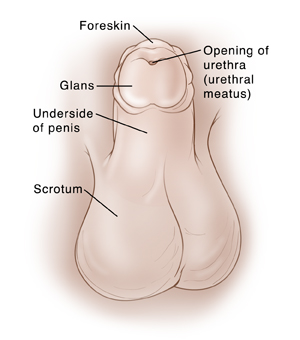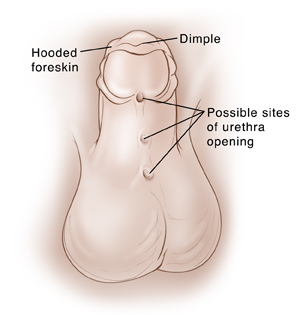When Your Child Has Hypospadias
When Your Child Has Hypospadias
Your child has been diagnosed with hypospadias. It affects only males. According to the CDC, about 5 in every 1,000 males born in the U.S. each year have this condition. It is usually not serious. It can almost always be corrected with surgery if needed. This sheet tells you more about your child’s condition.
|
What is hypospadias?
The tube that carries urine out of the body is called the urethra. It runs inside the penis to the opening where urine leaves the body (urethral meatus). Hypospadias occurs when a defect in your child’s urethra results in the abnormal location of the urethral meatus. Normally, the urethral meatus is located at the head of the penis (glans). But with hypospadias, the opening is on the underside of the penis, down near the scrotum, or in the area between the scrotum and the anus.
What causes hypospadias?
Hypospadias is congenital, meaning a child is born with it. In most cases, the cause is unknown.
What are the signs of hypospadias?
A child with hypospadias has a urethral meatus in an abnormal location. He may also have a penis that curves downward (chordee) and foreskin that doesn’t cover the glans (dorsal hood).
How is hypospadias diagnosed?
Hypospadias may be seen at your newborn’s physical exam.
How is hypospadias treated?
In mild cases, the urethra may not need correction. In moderate to severe cases, your child may need surgery to correct how the penis looks. Boys with hypospadias may not be circumcised as newborns. This is so the foreskin can be used to repair the urethra in the future. The repair surgery is usually done when the child is 3 to 18 months old. During surgery, the penis is straightened if needed. In some cases, you child may need more than one surgery.
What are the long-term concerns?
Left untreated, mild hypospadias often carries no long-term concerns. But in more serious cases, the condition can make it hard for the child to urinate normally. He may need to sit down to urinate. In severe cases, an adult male with untreated hypospadias may have trouble delivering sperm and getting a woman pregnant.
Updated:
October 08, 2017
Reviewed By:
Greenstein, Marc, DO,Image reviewed by StayWell medical illustration team.

